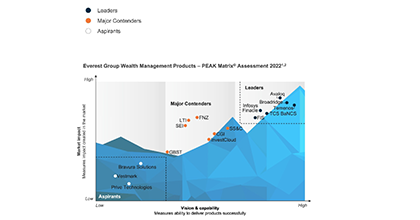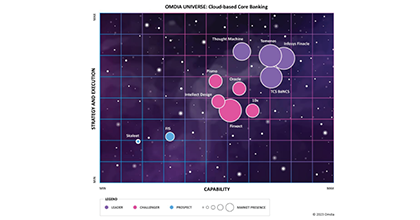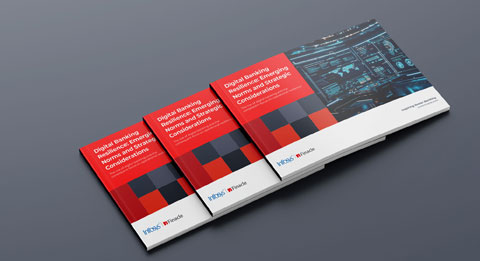With an ambition to operate fully from the cloud, the Union Bank of the Philippines has upgraded and already migrated more than 1000 workloads of its legacy, on-premise core banking system to the cloud-native Finacle Digital Banking SaaS suite running on AWS cloud. The bank aims to completely migrate its core banking system by 2024.
The bank won the Celent Model Bank Award 2023 for Cloud Migration. The award recognizes the best practices, the leadership vision, and the strong business outcomes that the Union Bank demonstrated in successfully modernizing and migrating its core banking platform to the cloud.
Read the interview with the Dennis Omila, Chief Information Officer, Union Bank of the Philippines, the cloud service provider, Wiley Battle, Partner Development Manager – FSI, Amazon Web Services (AWS) and the technology provider, Kalambur Venkatraman, Head – Product Architecture, Infosys Finacle to understand the strategy behind the success story.
Q1. Congratulations on winning the Celent Model Bank 2023 award! Can you tell us about your bank and the environment you operate in?
Dennis Omila: Union Bank has been one of the fastest growing banks in the country, onboarding around 1.2mn customers annually. This large and ever-growing volume of business created stress on our IT infrastructure. On the other hand, the formal banking sector is set to expand, encouraged by the central bank’s priorities. The growth of fintech companies is another reality that encouraged us to explore collaborating with them instead of treating them as competitors.
Q2. Your vision is to become the first bank to run completely on the cloud in the Philippines. You moved your core banking to the cloud as part of this vision. Could you share with us the motivations behind this strategic decision?
Dennis Omila: Overall, the market has been very encouraging, and we were looking at acquiring 25mn new accounts over the next few years.
We had to innovate faster with no room for errors to make the most out of the fast-growing market. We had to scale without the upfront cost of traditional approaches. Also, from a people perspective, we wanted our employees to be more efficient and creative. Of course, saving on infrastructure, reducing the total cost of ownership (TCO), and operating costs are always on the agenda. We knew the cloud was the answer to most of our needs.
We gave ourselves the target to operate fully in the cloud by 2023. In line with this, we migrated our on-premise core banking platform to the Finacle Digital Banking suite running on AWS. This move allows Union Bank to keep acquiring and delivering transactions for its clients without worrying about capacity or underlying infrastructure.
Q3. With a promise of agility, flexibility and control, hybrid cloud offers the best of both worlds. In your view, what is the role of a hybrid cloud approach in helping banks accelerate cloud success?
Dennis Omila: Hybrid cloud unlocks the flexibility for banks to progressively move their workloads to cloud, allowing them to scale their IT infrastructure as per their needs. They can use the public cloud for handling peak workloads or sudden surges in demand while maintaining sensitive data and critical applications on their private cloud. This flexibility unlocks the best of both world and ensures optimal resource allocation and cost-effectiveness. Also, by gradually transitioning specific applications or workloads to the public cloud, banks can assess the performance, security, and other factors before committing fully, thus minimizing the associated risks. Thus, in a way, Hybrid Cloud presents a carefully constructed, gradual, risk-mitigated and balanced approach for banks to progress along their cloud maturity journey.
Q4. Talk us through some of the benefits you have experienced post the migration to cloud.
Dennis Omila: We benefitted immensely on several counts. We were able to on-board 100K new customers every month during the pandemic, and rapidly on-board an additional one million customers from Citibank Philippines acquisition. This was huge!
We have become much more resilient with lower downtimes, data retrieval was 75% faster, and backups took just two hours instead of eight. Our employees were happier as they could do more in less time, worry less about the BAU operations and think more about innovating in their work areas.
We estimated TCO cost savings of 44% over a five-year period (compared to business-as-usual estimate) for our IT estate after moving to the cloud. In storage alone, we saved 35% annually. Our budgeting team was pleased since they didn’t have to forecast demand for fund allocation as we moved from a Capex to Opex model.
We believe, we will continue to benefit from this migration in the years to come, with a cloud-native core that makes us future-ready. We will be partnering more with new-age fintech companies to introduce new products for our clients.
Q5. What are the key learnings and success factors you think can be guideposts for others in the industry?
Dennis Omila: For us, the market offered all the opportunities we wanted. We were at the right place in the right time. Currently, Philippines is one of the fastest growing emerging markets in the world.
However, the credit for our success goes to the senior leadership. We were sponsored by both business and technology executives who drove the transformation by setting clear goals and strategic directions. We believe when moving to the cloud organizations must look at the various ways in which they can bring additional worth in the value-chain.
“Nobody gets left behind.” This philosophy continues, and a key element of our digital initiative is people and culture transformation. In this, as role requirements develop, we continue to upskill our people in areas such as robotics, agile methodology, design thinking, solution design, coding, and now, cloud.
Lastly, it is important to align with the current regulations and laws of the land and choose the right partners who share the same underlying objectives and common beliefs to improve the chances of success.
Q1. What are some of the biggest challenges that banks face today as they navigate through digital transformation and modernization amid intensifying competition from new-age players? What are banks like UBP getting right?
Kalambur Venkatraman: Banks today face a multitude of challenges. The needs of the digital-savvy customers are ever evolving and call for a personalized, digital service delivery. Margins are under pressure with the growing threat of digital-native challengers operating at a significantly lower cost to income ratio. Proliferation of digital transactions require banks to operate at a massive scale, while ensuring zero outages and downtimes. API-led newer business models mandate banks to invest in ecosystem strategies.
Progressive banks such as Union Bank of the Philippines, are leveraging technology to transform the way they serve their customers, run their operations and innovate with ecosystems. They are using the power of cloud to accelerate speed to market while strengthening resilience and operating at scale. Implementing cloud-native technology platforms, such as that of Finacle, they are harnessing the potential of an API and Event led architecture to unlock new possibilities. By investing in the right technology modernization initiatives at the right time, banks like UBP are staying ahead of the curve and future proofing their business. With the migration of the core banking platform to the cloud, Union Bank is geared to achieve greater pace in its digital innovation journey—launching newer and beneficial services that will enrich the customer experience. This will be to support the government’s wider drive for financial inclusion and growth of electronic payments. This is focused around leveraging Finacle’s open API repository, allowing it to develop its ecosystem strategy to innovate new services with the fintech community in the Philippines.
Q2. For banks still sceptical about moving from on-prem to cloud-native platform, what would you say are some of the key turning points that will compel the shift.
Kalambur Venkatraman: Firstly, it is important to realize that cloud native architecture is not all about deploying to public or private cloud. It is a paradigm that revolves around how modern-day applications are built to improve their manageability, scalability and change management. Unless they are built to cloud native architectural principles, moving them to either public or private cloud will yield no benefits. Cloud adoption is no longer a matter of choice, but an imperative. Banks, who are yet to embark on the cloud journey, must prioritize cloud investments as a major business transformation initiative. They should devise a comprehensive cloud strategy, tailored to their context, maturity and risk appetite. They can leverage a variety of application modernization approaches and can choose to progressively move their workloads to cloud or take a big bang approach. A hybrid cloud approach, encompassing workloads across on-premises, private cloud and public cloud will help them scale cloud maturity with the right balance between agility and control. They can also take a best of breed approach for choosing the most suitable cloud provider for different workloads, in a multi-cloud setup. Finally, they should continue to move not just peripheral systems, but also the mission critical workloads to cloud, in order to unlock its full potential.
Q1. What are some specific challenges you see banks struggle within their cloud migration journeys?
Wiley Battle: A lot of the biggest challenges for banks to move to the cloud aren’t technical, they’re about people and culture. The banks that have the most success in their cloud journey is often down to a few key things:
- The senior leadership team needs to be aligned and truly committed that they want to move to the cloud. And they need to be setting clear direction and expectations with the rest of the organization to get everyone on the same page and working towards the same thing. It is easy for others to do nothing or block things if the leadership team isn’t making the move a priority and building a culture for change.
- The most successful organizations moving to the cloud started with an aggressive top-down goal that forced the organization to move faster than it would have organically.
- It is really important that organizations are trained on the cloud and comfortable with the concepts as part of the whole process.
- Organizations can get paralyzed if they can’t figure out how to move every workload. So, AWS often works with organizations to do a portfolio analysis to assess each application and build a plan for what to move short term, medium term, and last. This helps organizations get the benefits of the cloud for many of their applications much more quickly, and it really helps inform how they move the rest.
Q2. What are the biggest takeaways of the engagement model between UBP, Finacle and AWS?
Wiley Battle: For a program like this to be successful, following ingredients for success are essential:
- Top down goal setting/ executive sponsorship – Union Bank’s cloud transformation would not have been as successful if it had not been for the aggressive, top down goals from Senior Leadership who realized the value and urgency of cloud.
- Strong collaboration between the stakeholders – on top of following regular cadences, there needs be a discipline to surface issues and risks with transparency so stakeholders (including business) are aware and can plan in advance. If a course correction (especially on technology choices) is required, it is better to do it early on.
- Clarity for the bank on what comes after – Moving the core banking platform to the cloud and leveraging the many managed services offerings of AWS, Union Bank’s teams can now focus on innovations and new product development, and on what really matters to their customers. Cloud transformation gives Union Bank an opportunity to rethink many of the pieces in their value chain. They chose to give AWS and its partners the undifferentiated heavy lift workloads, so that they could focus on innovating and improving their customer experience instead.





















